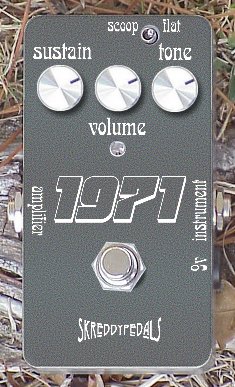Official Skreddy 1971 Page HERE

FYI: there may in fact be some original v1 EHX BMP’s out there in the wild that have this certain “overdrivey” flavor rather than over-the-top fuzz (one thing vintage BMP’s are known for is their variability, and I’ve read at least one account of a specimen having this nature). This design just has a few minor resistor value tweaks that pull back the gain enough to keep the specially-selected lower-gain 2N5133 transistors I’m using from going into full saturation.
General background on how I approach BMP builds: I base the whole circuit around the transistors. All transistors have a particular voice. Sometimes I select a transistor to help me achieve a specific voice I have in mind, but other times I map all the other circuit components around bringing out the natural character that the transistors already have. This is an example of the latter. These transistors have that v1 character and don’t require any special processing or filtering or tricks to make them sound great; I’m just letting them do what they do and keeping them operating within their comfort zone (lowering the gain in this case because lower-gain transistors saturate more easily) to eliminate nasty artifacts or mushiness.
Responding to an earlier inquiry about whether it sounds like a Screw Driver or a Hybrid Fuzz… No! It sounds like a dank, oldschool tube amp cranked to the gills. Or a low-gain vintage Big Muff if you will. It has a certain combination of creaminess and yet clarity, but it’s not transparent and touch-sensitive; not that. But it does give the impression of cooking tubes and pushed speaker cabinets as opposed to a solid-state distortion device.
I went just a hair more aggressive than usual on the extra mids with the mids toggle switched to the right on this one. The mids are so tasty on this circuit! Really I don’t think I am over-selling it with all the “amp-like” and “addictive” verbiage.
“
April 21 2017
New Skreddy 1971
One of the best things about the first-edition triangle-knob Big Muff Pi was its versatility and amp-like quality. With my new 1971 pedal, I’ve taken this a step farther and lowered the gain just enough to eliminate the fuzz-like syrupiness of the circuit just to exploit that vast cranked-amp distortion quality. It doesn’t swamp out your attack, so it retains an openness and is tight and very chord-friendly. It still sounds like you’re playing your guitar and not just playing a fuzz pedal, but, since it uses oldschool parts similar to those you’d find in a vintage 1971 Big Muff, it has that delicious oldschool flavor. Very “blast from the past” when you plug in and play. Check it out!